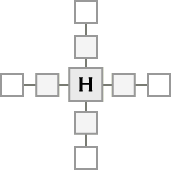Information architecture: Difference between revisions
mNo edit summary |
m (→Origins) |
||
| Line 20: | Line 20: | ||
{{quotation| I mean architect as in the creating of systemic, structural, and orderly principles to make something work--the thoughtful making of either artifact, or idea, or policy that informs because it is clear. }} | {{quotation| I mean architect as in the creating of systemic, structural, and orderly principles to make something work--the thoughtful making of either artifact, or idea, or policy that informs because it is clear. }} | ||
These principles have become the core of in [[HCI]], [[systems design]] and [[user-centered design]]. | These principles have become the core of in [[HCI]], systems design (including [[instructional systems design]]) and [[user-centered design]]. | ||
''Information architecture'' is now used most commonly to refer to the organization of information on the Web at a fairly high level, e.g. using [[web wireframe|wireframes]]. | ''Information architecture'' is now used most commonly to refer to the organization of information on the Web at a fairly high level, e.g. using [[web wireframe|wireframes]]. | ||
Revision as of 12:24, 11 March 2011
<pageby nominor="false" comments="false"/>
Definition
Information architecture (IS) (also referred to as information design) is the science of organizing and structuring of information for use in defined contexts. This may involve the classification and management of information as in library sciences or the structuring of a web or software architecture or the modeling of the relationships between data within a system.
A selection of definitions can be found at eleganthack.com.
Origins
Wyllys (2000) claims information architecture has its origins in architecture, and was brought into wide use by Richard Saul Wurman, who used the term to refer to the process of bringing together the multifaceted information contained within urban environments and representing them to multiple target users (city planners, architects, engineers, dwellers). Wurman likened this task to the function of an architect who must:
- “ascertain needs”
- “organize the needs into a coherent pattern that clarifies their nature and interactions”
- “design a building that will-- by means of its rooms, fixtures, machines and layout, i.e., flow of people and materials--meet the occupants' needs”
“In teams that can include visual designers, interface designers, navigation designers, information designers, and interaction designers, the information architect is free to focus on the structure and organization.”
The concept of information being embedded within an environment in a way that affords intended use and serves users' needs was extended by Wurman to design in general, where he sought to inform and "bring meaning or understanding" to space. “I mean architect as in the creating of systemic, structural, and orderly principles to make something work--the thoughtful making of either artifact, or idea, or policy that informs because it is clear.”
These principles have become the core of in HCI, systems design (including instructional systems design) and user-centered design.
Information architecture is now used most commonly to refer to the organization of information on the Web at a fairly high level, e.g. using wireframes.
An entirely different species of information architects formally models information structures, typically with XML.
Types of structures
- hierarchies: classifications such as the Dewey Decimal Classification system whose goal is to classify knowledge into categories, sub-categories, sub-sub-categories, etc.
- networks of nodes and links between nodes (non-hierarchical), such as the Web
- database-oriented models: pieces of information stored in fields and grouped into records and files with metadata to relate the fields and records
Information architecture models
From webdesignfromscratch.com, some models for structuring information within websites (this of course can apply to other computer-based media, e.g.: cdrom, intranet.
- All-in-one
- Flat
all pages of information are accessible from every page. All pages are on the same level. The homepage is one category among others. ![]() .
.
- Index
The homepage acts as an index to structure available information, as in an alphabetical index of a directory. 
- Hub-and-spoke / Daisy
Several interaction paths radiate from and return to a central page. 
- Strict hierarchy
Information organized into nodes and sub-nodes. There is only one path available to access a particular piece of information (or web page). A node may have multiple child nodes but each child node has only one parent node. This is a structure used by XML-based data structures. 
- Multi-dimensional hierarchy
A variant of the strict hierarchy, it allows for more flexible organization of information in that there may be sevaral paths of access for a particular information node. Child nodes may have multiple parents. This data structure upon which concept maps are based, is more difficult to maintain but can be the most highly 'networked'. 
- Search
More of a navigation tool than an architecture, it allows instant access to particular information without working through the hierarchy or index, but also not benefitting from the incidental learning that an explicit structure can offer. 
Links
- Web Design References - comprehensive collection of resources on IA.
- InfoMatters - Andrew Dillon’s Blog on the Architecture of Information
References
Spencer, Donna (2010). A Practical Guide to Information Architecture, Five Simple Steps, ISBN: 978-0-9561740-6-2 (online shop - Author's book home page - author's blog
- Wyllys, R.E. (2000). Information Architecture. Notes from LIS 386.13 class team at the Graduate School of Library and Information Science at UT-Austin. [1]